![]()
Ball Spin Detection Theory
![]()
Accuracy comparisons between measuring
Ball Spin from an overhead camera
vs
Ball Spin from a side mounted camera
Depending on ball image resolution,
the measured ball spin accuracy from a side mounted camera - that can view a full 360 degrees of rotation between frames -
will far exceed the accuracy of an overhead camera that can only view 70 degrees of rotation.
e.g. assuming a ball image size diameter of 50 pixels, there will only be around 34 pixels that will be in a useful area
where spin markings can be detected.
Thus each dot marking position will have an accuracy of 70/34 = 2.05 degrees
i.e. 1 pixel shift of the dot on the surface of the ball will equal 2.05 degrees of rotation of the ball
Depending on frame rate and actual spin rate, measured back spin accuracy will be in the +/- 300 rpm range.
In contrast, the measured back spin accuracy
of a side mounted camera that can view a total of 360 degrees of back spin over multiple frames will be in the +/- 10 rpm range
![]()
Measuring Ball Spin from an overhead ceiling mounted camera
using image pixel shift and rotation matching methods


Detecting ball spin with just a smudge mark on the ball




This method consists of taking an array of pixel levels of the ball image in 2 adjacent frames
and obtaining a match with a series of pixel shifting and rotation procedures.
Using this method, rotation (and thus back and side spin) can be detected even with just a smudge mark on the ball.
i.e. this method is not looking for any specific dots or markings on the ball
so any ball can be used as long as there's something on the ball that is not pure white.
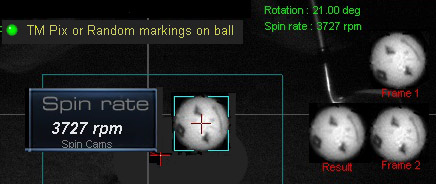
![]()
Testing the pixel shift and comparison method
![]()
Using CP version 10.2.7.0 or higher, you can try out the test I made to determine the amount of tolerance required when comparing pixel gray scale levels.
This is required as it is not likely (dues to varying light bounce) that there will be a 1 to 1 match.
After this has been determined, coding of a complete scan that tests all pixels for every x and y shift will be underway.
![]()
![]()
Note that it doesn't matter what type of marking is on the ball.
In this example I'm using ball images with dots on them but the method works just as well with any other ball marking.
Including just smudges
![]()
You can set any pair of ball spin images by selecting a frame of the ball in flight and clicking on the ball spin video image
![]()
Press ctrl key down and use up/down arrow keys to adjust match tolerance
![]()
Note that I'm doubling the ball image size to increase resolution and thus accuracy.
Once a match has been detected:
The amount of shift on the x axis that was required for the match determines the back spin.
The amount of shift on the y axis that was required for the match determines the side spin.
Testing the full scan pixel shift and comparison method
as of CP version 10.2.7.2
In order to detect the marking in ball frame 1 in ball frame 2,
use the left, right, up and down keyboard arrow keys to move the scan area in ball frame 2.
A matching score value will be calculated for every x and y movement of the scan area.
After moving the scan area area in all x and y directions, a best match score will be calculated.
This will give you the amount of x and y shift required to find the marking.
These values are then used to determine the back and side spin values.

Detecting spin from any random mark on ball

Detecting spin from ball logo

Detecting spin from Talor Made Pix balls
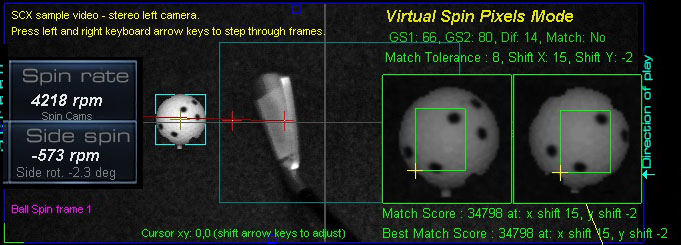
Measuring Ball Spin from an overhead ceiling mounted camera
using spin dot balls

Measuring spin from an overhead camera using spin dot balls as reference and measuring a partial rotation between frames.
Two measurements are required:
1. Vertical rotation back spin
2. Horizontal rotation side spin
From these two measurements a Total spin can be calculated
Total spin ?
Total spin is the vector sum of back and side spin rates which can be calculated as follows:
Total spin = square root of (back spin squared + side spin squared)


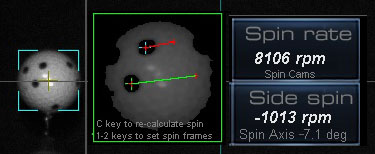

Rotation and side spin is calculated by comparing x and y co-ordinate spin dot deviation positions between frames on the ball.
Perspective mapping

In order to determine the amount of rotation, co-ordinate points on the ball as seen by the camera have to be transformed to real co-ordinate points.

When in virtual dot mode (press V key in camera panel) you can see how the dots on the surface on the ball image are projected onto a flat plane.
Angles are calculated between the dots on 2 adjacent frame images
The difference between the 2 angles ( known as the Delta angle ) represents the amount of ball spin rotation in degrees between 2 frames.
Together with the frame rate time, the spin rate can be calculated based on the amount of rotation using the below formula.
RPM = ( degrees of rotation / 360 degrees) / time in minutes.

Each point co-ordinate as seen from the overhead camera is mapped to the real circumference of the ball in both the x and y directions.
Whereby x co-ordinates are used to determine ball back spin and y co-ordinates are used to determine side spin (+ or -)

An additional arc length correction factor based on the dot's distance from the center line also has to be applied.
The real arc length of the two points can then be calculated.
Knowing the arc length and the radius of the ball, the arc central angle can be calculated.
This arc central angle is the back rotation in degrees (or radians) for a given time between the two frames (1 ms) and from this the back spin rate can be calculated.
Deriving arc length from 2 dot points
Pc = C/ d
(PC = Perspective Correction, C = ball circumference / 2, d = ball diameter)
pd1x = dot1x*Pc
pd2x = dot1x*Pc
(pd1x, pd2x = perspective corrected dot x co-ordinates)
Calculate off-center correction
chordlen1 = 2 × √(r2 − d2)
chordlen2 = 2 × √(r2 − d2)
(r = ball radius, d = y distance dot from ball center line)
offCenterFactor1 = chordlen1 / ball diameter
offCenterFactor2 = chordlen1 / ball diameter
Cdx1 = pd1x * offcenterFactor1
Cdx2 = pd2x * offcenterFactor2
ArcLen = Cdx1 - Cdx2
Deriving rotation from arc length
Calculate degrees of rotation given Arc length and ball radius
Use the formula: CA (Central Angle) = ArcLen * 360 / 2 π r
Calculate spin rate
Given time t (the time between 2 frames) and the amount of rotation within this time, calculate spin rate in rpm
Use the formula: Spin rate rpm = (r/t) / 6
where r = degrees of rotation
and t is the time in which the rotation occurs.
Divide by 6 to get RPM
Spin rate in RPM = w / 6




Note that only well defined and spaced spin dot balls can be used ( as shown above).
And that camera exposure time (i.e. shutter speed) has to be set at or below 150 micro seconds and frame set to 1500 fps
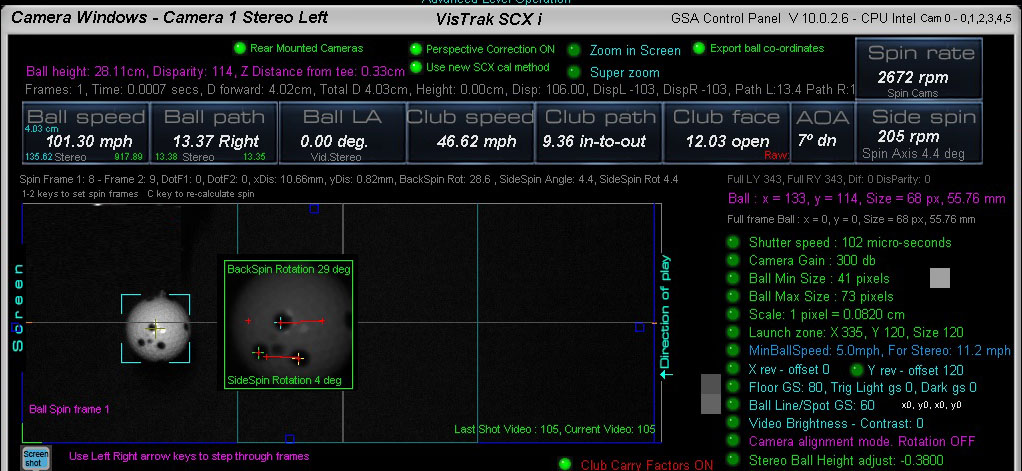

Note that the "Ball line/Spot GS" (Gray Scale) may ( depending on your lighting )
have to be adjusted up or down in order to detect the ball spin dot or ball logo.

The above image (from a customer shot video) shows the issue with longer exposure times
and out of focus lenses when attempting to detect ball spin dot markings.
Exposure times need to be under 150 us to reduce motion blur caused by the ball traveling at high speeds.
Nether-the-less, if increasing the Ball Spot GS (gray scale) to 200,
then even out of focus and blurry ball dots can be detected.
Today's CP version also features improved ball spin frame detection by attempting to find 2 adjacent
ball images that have at least 3 dots on them instead of just 2.
Ball Spin detection using the ball logo
for overhead SCX and Eagle systems


You can now select the option "Spin line / Logo on ball" to measure ball spin for overhead camera systems (i.e. SCX and Eagle).
As the logo will not always be visible in the frames, the system now automatically scans for 2 adjacent fames showing the ball logo
in all the 16 ball speed frames.
Measuring spin rate from an overhead camera using just the ball logo as reference and waiting for a complete 360 revolution.
This method requires capturing multiple frames of the spinning and moving ball.
To measure spin rate using just one reference marking (i.e. the ball logo), the captured frames would have to include a complete 360 rotation of the ball.
If the ball was just spinning and not moving forward, we could calculate spin rate by just counting the number of frames (and thus time) required for a complete 360 degree rotation,
Unfortunately for us here - in the game of golf - the ball is moving very fast, and thus hi-resolution frames have to be captured over a (competitively) long distance.
Example 1: assuming a ball speed of 150 mph and a frame rate of 800 fps = 1/800 = 1 frame per 0.00125 seconds
1. 1000 rpm = 7.5 degrees of ball rotation per frame = 360/7.5 = 48 frames required for a complete revolution. Distance ball has moved at 150mph in 48 x 0.00125 = 0.275ft x 48 = 13.25 ft
2. 2000 rpm = 15 degrees of ball rotation per frame = 360/15 = 24 frames required for a complete revolution. Distance ball has moved at 150mph in 24 x 0.00125 = 0.275ft x 24 = 6.6 ft
3. 4000 rpm = 30 degrees of ball rotation per frame = 360/30 = 12 frames required for a complete revolution. Distance ball has moved at 150mph in 12 x 0.00125 = 0.275ft x 12 = 3.3 ft
4. 8000 rpm = 60 degrees of ball rotation per frame = 360/60 = 6 frames required for a complete revolution. Distance ball has moved at 150mph in 6 x 0.00125 = 0.275ft x 6 = 1.65 ft
As can be seen from the above calculations, measuring ball spin using just the ball logo and a FOV of a camera mounted at 9ft with a 12mm lens won't work.
i.e. the ball will be out of the FOV of the camera in most spin rate cases.
In order to resolve the issue, the FOV of the camera and lighting would have to be substantially increased using a 6mm lens - which isn't going to be practical
Spin axis and side spin
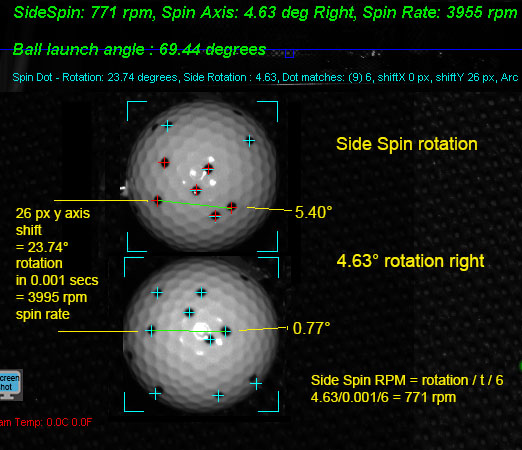

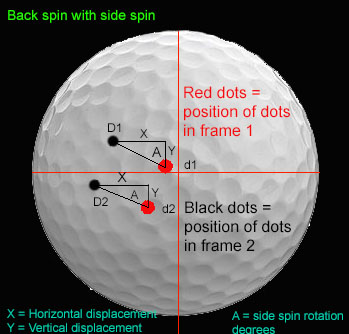
As we all know, there's no such thing as side spin but the camera does see horizontal rotation (side spin) as well as vertical rotation (back spin).
As the camera sees the two 2D images of the ball, it would look like the ball is rotating in 2 directions at the same time but that is only due to the spin axis being tilted.
Camera tests revealed that as long as the ball is struck square to the club path (no matter if path is straight, in-to-out or out-to-in), then no side spin or spin axis tilt is imparted on the ball.
If club face differs from club path, then side spin and axis tilt can be detected.
Spin axis

As ball spin axis is 3 dimensional, it cannot be shown as a simple number of degrees.
in order to actually show spin axis, you'd have to calculate a 3D vector which the average golfer wouldn't easily comprehend.
Virtual spin dots for SCX testers
The virtual spin dot mode is basically just a tool used by GSAgolf to simulate ball markings on the ball
and to view the resulting measured back and side spin rate
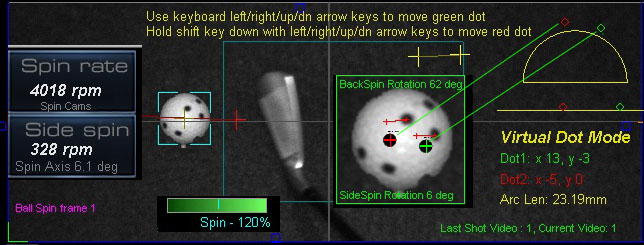
Virtual spin dots are used to test the spin detection method.
In the camera panel, Select a frame with a ball shown in it.
Select spin dot or logo on ball spin method.
Press the V key on your keyboard to go to Virtual Dot Mode
Use arrow left/right/up/ down keyboard keys to move dots around on the ball
The dots can be moved around anywhere on the ball image
and the resulting back and side spin rates - based on their co-ordinates - will be automatically shown.
New Ball Spin detection using the ball logo
for overhead SCX and Eagle systems


You can now select the option "Spin line / Logo on ball" to measure ball spin for overhead camera systems (i.e. SCX and Eagle).
As the logo will not always be visible in the frames, the system now automatically scans for 2 adjacent fames showing the ball logo
in all the 16 ball speed frames.
VisTrak LX or EVi Ball Spin Detection
Ball Back Spin Detection from the Side camera
![]()
Using the ball logo or line

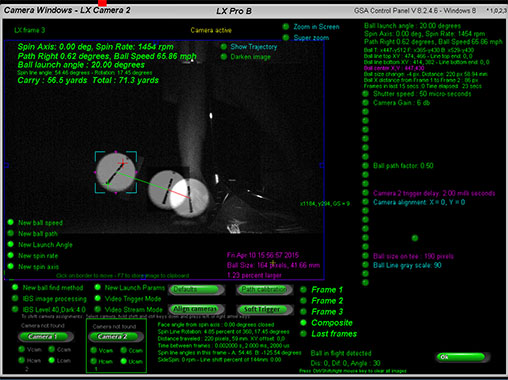
When the EVi or LX Vcam is placed close to the ball (i.e within 12 to 16 inches),
the camera detects ball spin rate using either the ball logo or ball spin dots.

Ball Side Spin Detection from the Side camera
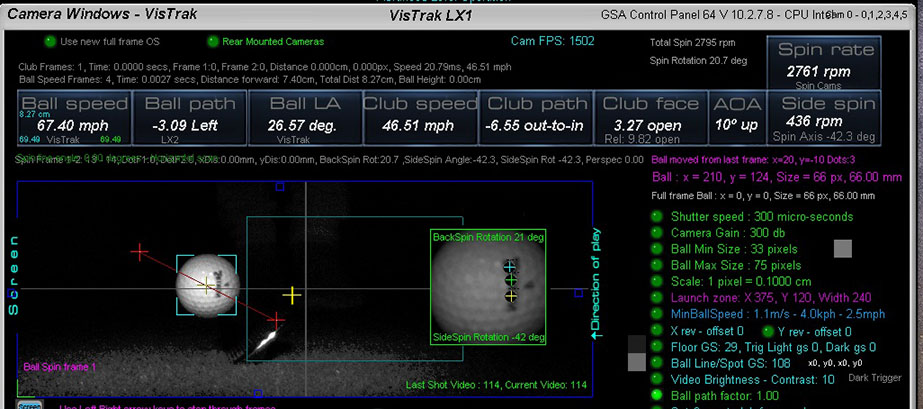


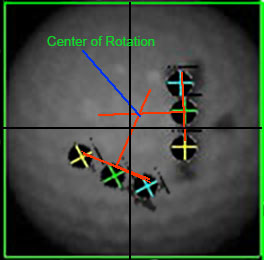
In order to detect side spin with a side mounted camera,
we need to determine if the ball's logo or marking is rotating around the center of the ball in both ball spin frames.
If the distance each point of the logo or marking is from the center is the same in both frames, then spin axis is not tilted and thus there is no side spin.
Any deviation will show that the ball's spin axis is tilted and thus there will be side spin present
Center of ball rotation (green cross-hair) and spin axis now displayed in spin video box for side mounted camera systems (LX, EV)


Source code for calculating the center of rotation
New spin detection method for side mounted camera systems (i.e. EV and LX)

The method consists of rotating ball spin frame 1 in single degree steps and comparing it to the ball spin image 2.
A best match test is performed which returns the amount of rotation between the two frames.
Knowing the amount of rotation and the time taken, accurate ball spin can be calculated.
Note that any ball markings can be used.

Using Taylor Made PIX balls

Using just the ball's logo
![]()
Using balls with spin dots on them

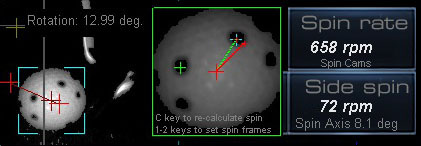
The Vcam with EVi and LX systems view the ball from the side.
Rotation - when using spin dot balls - is calculated around the center of the ball between frames

Note that the "Ball line/Spot GS" (Gray Scale) may have to be adjusted up or down in order to detect the spin dot or ball logo/line.
![]()
EV / LX2 Ball Spin Detection from the overhead camera
Ball spin can also be measured from the EV overhead camera


Rotation and spin axis is calculated by comparing x and y spin dot deviation positions between frames
![]()
Ball spin for Putts
Measured ball spin when putting is done without the requirement to use ball markings.

Ball Spin rate accuracy verification method
In order to verify the ball spin rate accuracy of the VisTrak SCX system,
we'll need a solid reference. i.e. frames of a spinning ball with a known spin rate.

To do this, we used a variable speed DC motor with a marked golf ball on it.
First we'd have to accurately measure the spin rate of the motor.

This was done by using a laser tachometer and a black rubber disc with a white strip on it attached to the motor's spindle.
In this case, the reading was 2488 rpm
Note that you can't use a tachometer with a golf ball because laser tachometers only read single white markings on a dark background.

We then replaced the black rubber disc with a marked golf ball on the motor's spindle
and setup the VisTrak camera to capture 32 frames of the spinning ball.

We then compared the spin rate readings from the VisTrak SCX cameras with the tachometer reading.
The small discrepancy was rectified by increasing the spin rate adjust factor from 100 to 109 percent
![]()
Ball Spin Test Videos
For those that are interested, I've made a collection of ball spin videos using line/logo marked balls, QED marked balls and Rapsodo marked balls.


Click the above image to download the videos (32 MB compressed)
All 32 frame videos were captured at 1500 fps with the ball spinning at 2488 rpm.
Each ball type consists of 4 different viewing angles: Top, Side, Tilted Top and Tilted side.
To try the videos, copy the video number from the downloaded sub folder into the C:\ GSAgolf folder on your PC.
Go to the Videos panels and select the video number and go to camera 1.
Select any frame and press the 1 key on your keyboard, then go to the next frame and press the 2 key.
Then either press the C key or click on the spin video box to re-calculate the spin rate from the 2 frames you have previously selected
GSA Golf use these ball spin videos to simulate various ball marking position scenarios to confirm the correct measured ball spin
![]()
![]()

![]()